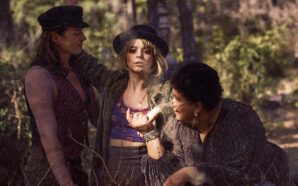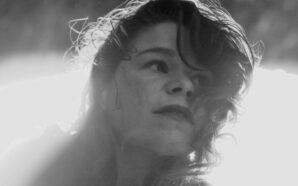Australia’s The Oyster Murders began when Grant Redgen relocated from the [what he considered to be] creatively numbing countryside to the city of Brisbane and met Wendy, a student of entertainment business. The two formed a cosmic connection of sorts, began making music, and went on to get married. Friends Shaun Edwards and Chris Macpherson soon joined them and they formed The Oyster Murders, an existentially heavy dream pop outfit, influenced in equal parts by ‘90s shoegaze and alt psyche and Lewis Carroll’s Through the Looking Glass (which inspired the band’s moniker). 2012 saw the release of their debut LP, Winter of the Electric Sun, and this September they released their follow-up EP, Mourning Birds. They currently have plans to return to the US (or at least NYC) and to record a sophomore LP. In a recent chat Wendy Redgen told me about the origins of The Oyster Murders and the art/media that rocks their world.
Izzy Cihak: First of all, I have to say that I just fucking love your name and am curious if you have any other especially profound non-musical influences, in addition to Carroll? I’m a humanities professor and a cinephile, so I often find those kind of influences a lot more interesting than a band’s musical influences.
Wendy Redgen: Thanks. We love it when people get the reference. Usually they just think we’re a heavy metal band (laughs). Most of my inspiration for lyrics and themes for songs come from movies and books. “Feed Ourselves to the Wolves,” for example, is an homage to Aldous Huxley’s Brave New World. We were watching a lot of old-school sci-fi around the time of writing the EP, like Twilight Zone, also reading a lot of Stephen King and watching documentaries about Stephen Hawking’s theories. “Oh Shadow a Dark Crow Grow” is actually based around string theory.
IC: I also really love your music videos. They remind me of 120 Minutes and a time when people who really “got” what made for cool and interesting music also had a knowledge of film history and what makes for something that’s cinematically interesting, as well. Do you have any visual artists or film movements that you’re especially a fan of or inspired by?
WR: Thank you. We’re lucky enough to have worked with some very talented young directors, who have understood our style and could help us transpose that onto the screen. We try to keep the themes of our clips simple so we can focus on making them look visually appealing and embellish elements of the music. “Disaster Flower Bloom” was really inspired by Twin Peaks. We wanted to create this eerie, dream-like sequence so we learnt how to sing and play parts of the song backwards and choreographed these movements around the space to give the whole thing an abstract feeling.
[youtube http://youtu.be/hLzEMyW29_I]
IC: What have been The Oyster Murders’ highlights of 2013, in addition to the release of Mourning Birds?
WR: The year has gone by very fast. We’ve had a massive last 12 months, with the release of our debut album and a trip over to the states to play at the CMJ Music Marathon, and then we didn’t have much downtime before jumping right back into the writing process for this EP. One of the highlights for me was working with a great team of filmmakers on “Oh Shadow a Dark Crow Grow.” I really enjoyed being able to perform a song in its entirety in a film clip. I know Grant also really enjoyed being involved in the filmmaking process, even just watching the colour grading happen. One of the great things about being involved in music is you get exposed to a lot of creative environments and get to learn a lot from other creative people.
[youtube http://youtu.be/Sce-RIbfC2U]
IC: Have you had any favorite reactions to your latest EP?
WR: For me, I always love the first time I get to sit down and play the finished song to my family. You put a lot of time and energy into creating something that you’re proud of and one of the best things about that process is being able to share that with the people you love.
IC: Do you have a particular favorite track, or a track which best hints at where your future sounds might be headed? I’m really into “The Atlantis Quarterly.”
WR: It’s interesting, “The Atlantis Quarterly” was one of the songs that had the fastest turnaround, as far as the writing process goes. We wanted to keep it as a pretty straightforward track and not complicate it too much, just push the energy of it and add some interesting elements. I really loved the synth sounds in this track, very distorted, but still whimsical. I think it’s the direction we’re heading in the future, even “Feed Ourselves to the Wolves,” there’s a lot of raw energy there. I think our next stuff is going to be even more out there, a bit freaky, and hopefully pretty cool.
IC: I understand that you have a trip to the states planned for 2014 to play some shows. What should be expected of the live experience?
WR: We try to bring a lot of genuine emotion to our live shows. It’s a challenge capturing everything from the recorded song and recreating that in a live context so sometimes we adapt and change things out of necessity or just for fun. Playing a live show isn’t always a happy experience. Things go wrong, shit happens, but when performing you have to take what you’ve got and use it, so sometimes we’re a sweet, dreamy band, and sometimes we’re angsty, and always keenly human.








